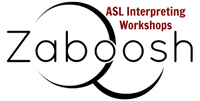Who Do Interpreters Think We Are? Rooting Today’s Triumphs and Crises in Our Distant Past

Workshop Description:
|
Part I: Hearing Interpreters. Before the rise of Deaf education, Deaf-led communities, and standardized signed languages, who were the first interpreters? Surprising case studies reveal that truly little has changed in nearly 250 years. Participants will cheer and cringe for their colleagues as judges coach or censure untrained interpreters. We’ll also celebrate progress, as some expectations of historical interpreters are gratefully no longer generally applied. Selected mileposts in the discussion that created, refined, and endorsed the use of sign language interpreters in legal settings include: • 1324: A Deaf man consents “by signs” that his brother-in-law manage his estate, yet kept the profits to support his family. His hearing wife was likely the mediator. • 1624: The first legal text claiming interpreter practice carries “like Efficacy, as if [the Deaf persons] themselves had mutually expressed the words”. • 1789: An oath for sign language interpreters is published, citing a case wherein the interpreter endured the voir dire to such a degree, it became a powerful precedent. • 1811: Services of the first known, officially sworn interpreter for a Deaf defendant in the US are admitted with no discussion or objection. Part II: Deaf Interpreters. Many 19th-century hearing interpreters were drawn from schools for the Deaf. But they were not working alone—meet the inspiring Deaf interpreters from 19th-century court cases in the UK and US, and admire their lives, and creative interpreting strategies under pressure. Details from cases include: • A Deaf and hearing team of interpreters are called from a school for the Deaf to assess whether an illiterate, uneducated Deaf murder suspect is fit for trial. Both testify and their opinions directly affect the outcome of the case. • After struggling without an interpreter, a country judge allows a Deaf schoolmate (of majority age) of the plaintiff to team with an unqualified hearing interpreter in a case of juvenile sexual assault. • A Deaf boy witnesses a murder and the defendants are convicted, but his testimony is overturned by a higher court. At re-trial, a Deaf instructor from his school accompanies him, and communicates with court personnel entirely in writing. |
Presenter Bio:
Anne grew up in St. Louis, Missouri, the home to three schools for Deaf children, and minutes away from the St. Louis Club for the Deaf. However, she never visited any of those places—the schools were all privately operated, and taught only through speechreading. All of the locals she met used their voices, and she never saw people signing in public. She quickly chose language as her specialty, and entered kindergarten with a 5th grade reading level.
While at Brigham Young University, Anne’s roommates wanted the apartment to take a class together, and decided on American Sign Language. Two months after they began in January 1988, the Deaf President Now protest at Gallaudet University left a permanent impact on both the Deaf and interpreting communities. Each semester at BYU, another roommate would bow out, and in the end, Anne is the only one who signs in a professional capacity, or at all. She began interpreting in November 1989, and was certified by the Registry of Interpreters for the Deaf in 1994. She is very much a product of her time, and the trajectory of arriving just as the interpreting field accelerated its progress through social and legislative actions.
Her master's thesis found Anglo–American legal interpreting practice with signing deaf parties developed before Deaf schools, signed languages, and communities were formed. She is currently expanding her historical study through a PhD by research in Translation Studies at the University of Birmingham (UK), to be completed in 2019. Anne has taken her private practice to the Chicago and Washington, DC areas, and is now based in Salt Lake City, Utah, but continues to travel nationwide and internationally on assignments.
For more information, please see interpreterhistory.com, Facebook at InterpreterHistory, or Twitter @interphistory.
